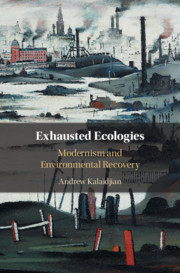Book contents
- Exhausted Ecologies
- Exhausted Ecologies
- Copyright page
- Contents
- Illustrations
- Acknowledgments
- Abbreviations
- Introduction: Places of Rest
- Chapter 1 Nature’s Reserves: Rural Exhaustion, Inertia, and Generative Aesthetics
- Chapter 2 Urban Environs: James Joyce and the Politics of Shared Atmosphere
- Chapter 3 Waste Lands: Dark Pastoral in T. S. Eliot, W. H. Auden, and Djuna Barnes
- Chapter 4 Uprooting Empire: Jean Rhys and Unrest in Imperial Centers
- Chapter 5 Decolonizing Ecology: Chinua Achebe’s New Forms of Unease
- Conclusion: The Limits of Modernist Regeneration
- Notes
- Bibliography
- Index
Chapter 3 - Waste Lands: Dark Pastoral in T. S. Eliot, W. H. Auden, and Djuna Barnes
Published online by Cambridge University Press: 09 January 2020
- Exhausted Ecologies
- Exhausted Ecologies
- Copyright page
- Contents
- Illustrations
- Acknowledgments
- Abbreviations
- Introduction: Places of Rest
- Chapter 1 Nature’s Reserves: Rural Exhaustion, Inertia, and Generative Aesthetics
- Chapter 2 Urban Environs: James Joyce and the Politics of Shared Atmosphere
- Chapter 3 Waste Lands: Dark Pastoral in T. S. Eliot, W. H. Auden, and Djuna Barnes
- Chapter 4 Uprooting Empire: Jean Rhys and Unrest in Imperial Centers
- Chapter 5 Decolonizing Ecology: Chinua Achebe’s New Forms of Unease
- Conclusion: The Limits of Modernist Regeneration
- Notes
- Bibliography
- Index
Summary
Chapter 3 explores modernist uses of the pastoral that deny the escape into nature and emphasize instead the biological limitations of human life. This dark pastoral mode coincides with setbacks to nature preservation in the United Kingdom during and following WWI and heightening during the economically stressful 1930s. Beginning with the iconic presentations of decay and destruction found in T. S. Eliot’s The Waste Land, the chapter considers Eliot’s symbolic registers of waste and regeneration in relation to actual attempts at land restoration in the United Kingdom. As the first large land holding entrusted to the Society for the Promotion of Nature Reserves, the case of Woodwalton Fen presents the tensions between “reserving nature” and “putting lands in order.” The undoing of pastoral retreat at the hands of anthropogenic control develops further in the early poems of W. H. Auden and arrives most forcefully in the fiction of Djuna Barnes, whose dark pastoral aesthetic subverts Thoreauvian notions of self-sufficiency in nature. Robin Vote as the “black sheep” in Djuna Barnes’s 1936 novel Nightwood poses a queer resilience to those who seek to tame and exploit living beings.
Keywords
- Type
- Chapter
- Information
- Exhausted EcologiesModernism and Environmental Recovery, pp. 102 - 139Publisher: Cambridge University PressPrint publication year: 2020

